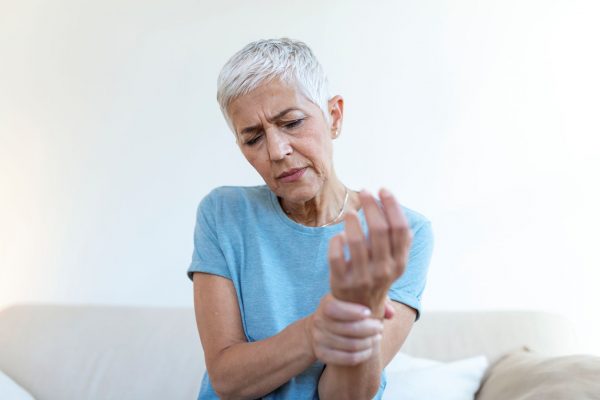I’ll bet you didn’t know this but, historically, arthritis was not the plague that it is today. Prior to the mid 1900’s, the prevalence didn’t change a lot. But it has nearly doubled since the World War II era.
🤔What the heck happened between then and now?
- Mainstream medicine began relying on drugs with their attendant side effects as the first line of treatment for arthritis pain.
- America, as a whole, became less physically active. This resulted in less healthy maintenance of joint cartilage and weaker muscles.
- Ultra Processed foods and refined carbs took over our diets.
- Extra weight piled on, adding stress to our already vulnerable joints.
- All of the above triggered chronic low-grade inflammation.
In a nutshell, instead of promoting healthy lifestyle activities, mainstream medicine is now treating osteoarthritis (OA) with anti-inflammatory pain meds, narcotics and corticosteroids that do nothing to treat the disease… and could make things much worse.
😢Why Your Joint Pain is a Crying Shame
If you’ve ever experienced any type of joint pain, you know that the first thing your doc will do is recommend an NSAID pain reliever. These days, some doctors are even prescribing opioid pain relievers to patients with arthritis. As a matter of fact, arthritis is one of the most common conditions among chronic users of opioids in the U.S.
That’s just a crying shame…
I warn all of my patients against NSAIDs. They do very little to alleviate pain, and they greatly increase your chances of a heart attack or stroke. (This is true even if you only use them for a few days.) They also damage your kidneys, gut and can cause liver failure.
To top it off, NSAIDs actually accelerate OA. In fact, NSAID users require joint replacements more often than patients who don’t use them.
And nobody wants to become addicted to opioids, especially when so many natural and harmless pain relief options are available.
Corticosteroid injections are just as bad, even worse in some ways.
While these injections may help relieve pain for a short while, they can actually worsen your arthritis. They damage bone and cartilage, cause rapid joint destruction, lead to stress fractures and may accelerate the need for joint replacement surgeries.
They also decrease immune system response and can affect blood sugar levels in people with diabetes.
🙌Best Relief for Arthritis Pain
The chance of experiencing OA in your lifetime is 40% or higher. So if you don’t have any symptoms, you’ll want to make sure it stays that way. (And even if you already have symptoms, you can still make choices that can improve your physical function and reduce pain levels.)
It’s especially important to maintain strong leg muscles to support your knees, since knee OA is so common. If your knees are normally pain-free, exercises like squats, lunges and sprints are great for these muscle groups.
If your knee joints are already painful, opt for low impact activities. Walking, bicycling and swimming are generally great for everyone. Performing exercises in the pool is a great idea, too. And a lot of my patients see great knee benefits with traditional tai chi and yoga sessions.
I also recommend eating a healthy Mediterranean style diet that helps slow down the decay of cartilage and slashes inflammation. It can also help you lose weight, which is a big factor when it comes to sidestepping arthritis. Carrying around excess pounds is strongly linked to the development of arthritis, particularly when it comes to the knees.
As far as supplementation is concerned, hyaluronic acid (HA) is a great weapon when it comes to cushioning joints. It works as a lubricant and shock absorber for your joints. That means it reduces friction and reduces wear and tear on the joints. This, in turn, reduces pain and makes joint movement easier.
In two different studies presented at the 2022 annual meeting of the Radiological Society of North America, patients were injected with either corticosteroids or hyaluronic acid. Both treatments helped with pain relief.
But, as suspected, those receiving corticosteroids had significantly more osteoarthritis progression. The hyaluronic acid group, on the other hand, showed a decrease in the progression of OA.
This suggests that hyaluronic acid injections may be a safer treatment option for those who experience severe pain associated with arthritis.
I also like green lipped mussel extract. Just 150 mg. daily can reduce joint tenderness, morning stiffness and improve pain levels.
Curcumin is another great pain fighter. Take 500-1,000 mg. twice a day to shut down inflammation. Look for one that contains 2-5 mg of bioperine (a black pepper extract) to help boost absorption.
Your joints are meant to last a lifetime. And with the right care, movement, nutrition, and natural support you can stay active, pain-free, and strong well into your later years.
SOURCES:
Wallace IJ, Worthington S, Felson DT, Jurmain RD, Wren KT, Maijanen H, Woods RJ, Lieberman DE. Knee osteoarthritis has doubled in prevalence since the mid-20th century. Proc Natl Acad Sci U S A. 2017 Aug 29;114(35):9332-9336.
Khoja SS, Almeida GJ, Freburger JK. Recommendation Rates for Physical Therapy, Lifestyle Counseling, and Pain Medications for Managing Knee Osteoarthritis in Ambulatory Care Settings: A Cross-Sectional Analysis of the National Ambulatory Care Survey (2007-2015). Arthritis Care Res (Hoboken). 2020 Feb;72(2):184-192.
Baumbach L, Roos EM, Lykkegaard J, Thomsen KS, Kristensen PL, Christensen AI, Thorlund JB. Patients with osteoarthritis are least likely to receive lifestyle advice compared with patients with diabetes and hypertension: A national health survey study from Denmark. Osteoarthr Cartil Open. 2020 Apr 18;2(3):100067.
FDA Drug Safety Communication: FDA strengthens warning that non-aspirin nonsteroidal anti-inflammatory drugs (NSAIDs) can cause heart attacks or strokes. Safety Announcement. U.S. Food and Drug Administration. July 2015.
Arthritis Foundation. Arthritis By the Numbers / Book of Trusted Facts & Figures. 2020.
Cho E, Curhan G, Hankinson SE, Kantoff P, Atkins MB, Stampfer M, Choueiri TK. Prospective Evaluation of Analgesic Use and Risk of Renal Cell Cancer. Archives of Internal Medicine. 2011; 171 (16): 1487.
Hauser, RA. The Acceleration of Articular Cartilage Degeneration in Osteoarthritis by Nonsteroidal Anti-inflammatory Drugs. Journal of Prolotherapy. 2010;(2)1:305-322.
Kompel AJ, Roemer FW, Murakami AM, Diaz LE, Crema MD, Guermazi A. Intra-articular Corticosteroid Injections in the Hip and Knee: Perhaps Not as Safe as We Thought? Radiology. 2019 Dec;293(3):656-663.
Song J, Gilbert AL, Chang RW, Pellegrini CA, Ehrlich-Jones LS, Lee J, Pinto D, Semanik PA, Sharma L, Kwoh CK, Jackson RD, Dunlop DD. Do Inactive Older Adults Who Increase Physical Activity Experience Less Disability: Evidence From the Osteoarthritis Initiative. J Clin Rheumatol. 2017 Jan;23(1):26-32.
Dyer J, Davison G, Marcora SM, Mauger AR. Effect of a Mediterranean Type Diet on Inflammatory and Cartilage Degradation Biomarkers in Patients with Osteoarthritis. J Nutr Health Aging. 2017;21(5):562-566.
Steroid Injections Worsen Knee Arthritis. Radiological Society of North America. Press Release. Nov 2022.
Migliore A, Procopio S. Effectiveness and utility of hyaluronic acid in osteoarthritis. Clin Cases Miner Bone Metab. 2015 Jan-Apr;12(1):31-3.
Coulson S, Vecchio P, Gramotnev H, Vitetta L. Green-lipped mussel (Perna canaliculus) extract efficacy in knee osteoarthritis and improvement in gastrointestinal dysfunction: a pilot study. Inflammopharmacology. 2012 Apr;20(2):71-6.
Bideshki MV, Jourabchi-Ghadim N, Radkhah N, Behzadi M, Asemani S, Jamilian P, Zarezadeh M. The efficacy of curcumin in relieving osteoarthritis: A meta-analysis of meta-analyses. Phytother Res. 2024 Jun;38(6):2875-2891.



